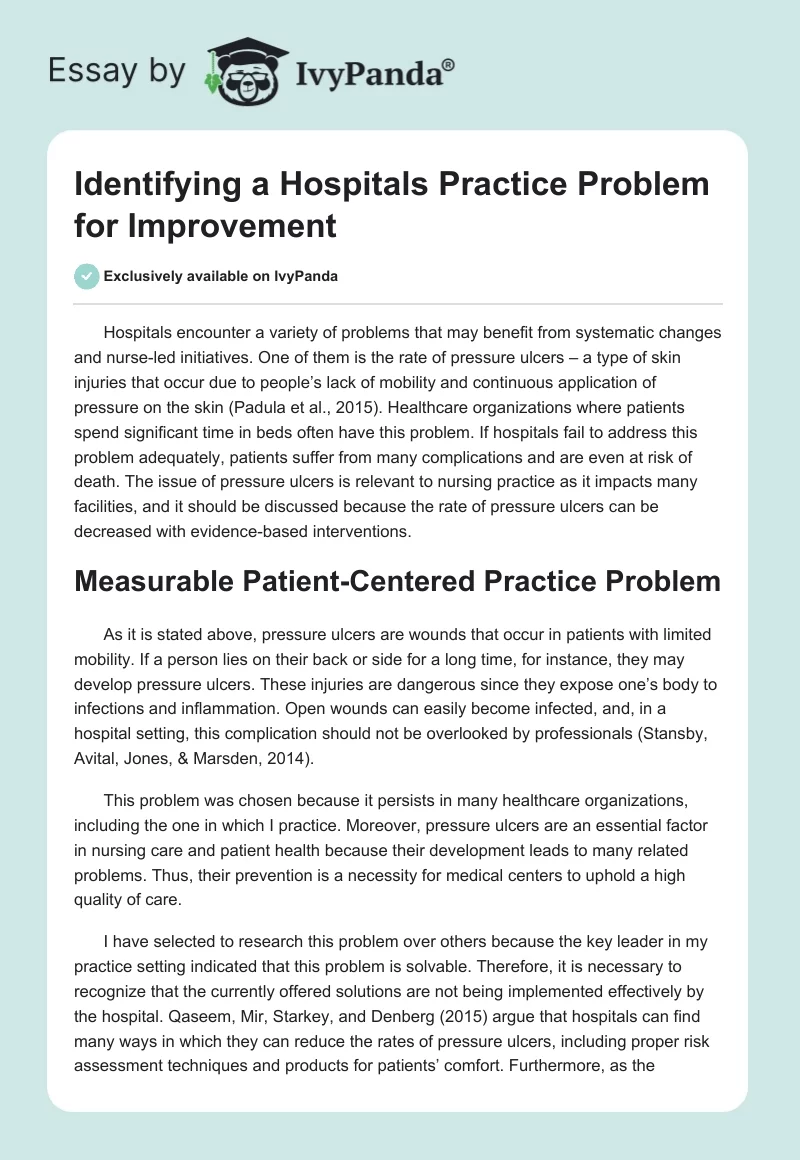Hospitals encounter a variety of problems that may benefit from systematic changes and nurse-led initiatives. One of them is the rate of pressure ulcers – a type of skin injuries that occur due to people’s lack of mobility and continuous application of pressure on the skin (Padula et al., 2015). Healthcare organizations where patients spend significant time in beds often have this problem. If hospitals fail to address this problem adequately, patients suffer from many complications and are even at risk of death. The issue of pressure ulcers is relevant to nursing practice as it impacts many facilities, and it should be discussed because the rate of pressure ulcers can be decreased with evidence-based interventions.
Measurable Patient-Centered Practice Problem
As it is stated above, pressure ulcers are wounds that occur in patients with limited mobility. If a person lies on their back or side for a long time, for instance, they may develop pressure ulcers. These injuries are dangerous since they expose one’s body to infections and inflammation. Open wounds can easily become infected, and, in a hospital setting, this complication should not be overlooked by professionals (Stansby, Avital, Jones, & Marsden, 2014).
This problem was chosen because it persists in many healthcare organizations, including the one in which I practice. Moreover, pressure ulcers are an essential factor in nursing care and patient health because their development leads to many related problems. Thus, their prevention is a necessity for medical centers to uphold a high quality of care.
I have selected to research this problem over others because the key leader in my practice setting indicated that this problem is solvable. Therefore, it is necessary to recognize that the currently offered solutions are not being implemented effectively by the hospital. Qaseem, Mir, Starkey, and Denberg (2015) argue that hospitals can find many ways in which they can reduce the rates of pressure ulcers, including proper risk assessment techniques and products for patients’ comfort. Furthermore, as the occurrence of pressure ulcers lead to a variety of complications, they endanger patients and affect their overall wellbeing. According to Padula et al. (2015), hospital-acquired pressure ulcers impact the morbidity and mortality of patients substantially.
Next, it should be noted that many healthcare organizations have similar concerns in regards to their ineffectiveness in dealing with pressure ulcers. For example, the available data indicate that the discussed practice setting is an average performer in comparison to other hospitals in the region. However, the example of poor performers reveals that the state’s indicators are not as high as they could have been. The rates reveal that most hospitals have more than 1 out of 1000 patients developing pressure ulcers during their stay (NYS Health Profiles, n.d.). In the present setting, this number may have reached 1 in 800 patients in previous years. The low number of high-performing medical facilities also suggests that this is a pressing problem for many healthcare providers.
Conclusion
The issue of pressure ulcers acquired in hospitals is a topic that should be researched by advanced care nurses in more detail. The rates of the problem’s occurrence are high in many healthcare facilities which often fail to implement new recommendations and prevention initiatives adequately. In my practice setting, the indicators reveal an average performance. However, it is clear that patient outcomes can be improved by targeting pressure ulcers. Finally, there exist many ways to prevent or mitigate the effects of pressure ulcers. Thus, healthcare facilities’ inability to improve their setting should be challenged.
References
NYS Health Profiles, (n.d.). Pressure ulcer. Web.
Padula, W. V., Makic, M. B. F., Mishra, M. K., Campbell, J. D., Nair, K. V., Wald, H. L., & Valuck, R. J. (2015). Comparative effectiveness of quality improvement interventions for pressure ulcer prevention in academic medical centers in the United States. The Joint Commission Journal on Quality and Patient Safety, 41(6), 246-256.
Qaseem, A., Mir, T. P., Starkey, M., & Denberg, T. D. (2015). Risk assessment and prevention of pressure ulcers: A clinical practice guideline from the American College of Physicians. Annals of Internal Medicine, 162(5), 359-369.
Stansby, G., Avital, L., Jones, K., & Marsden, G. (2014). Prevention and management of pressure ulcers in primary and secondary care: Summary of NICE guidance. BMJ, 348, g2592.


